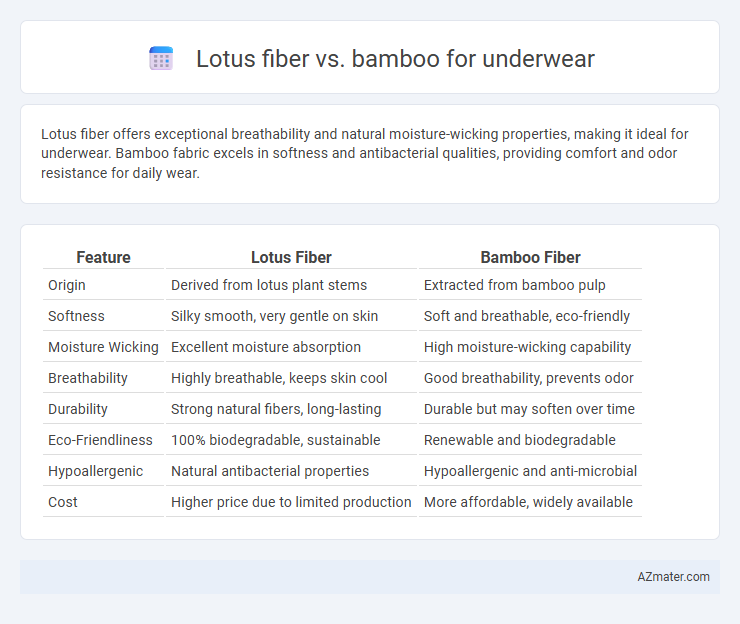Lotus fiber offers exceptional breathability and natural moisture-wicking properties, making it ideal for underwear. Bamboo fabric excels in softness and antibacterial qualities, providing comfort and odor resistance for daily wear.
Table of Comparison
| Feature | Lotus Fiber | Bamboo Fiber |
|---|---|---|
| Origin | Derived from lotus plant stems | Extracted from bamboo pulp |
| Softness | Silky smooth, very gentle on skin | Soft and breathable, eco-friendly |
| Moisture Wicking | Excellent moisture absorption | High moisture-wicking capability |
| Breathability | Highly breathable, keeps skin cool | Good breathability, prevents odor |
| Durability | Strong natural fibers, long-lasting | Durable but may soften over time |
| Eco-Friendliness | 100% biodegradable, sustainable | Renewable and biodegradable |
| Hypoallergenic | Natural antibacterial properties | Hypoallergenic and anti-microbial |
| Cost | Higher price due to limited production | More affordable, widely available |
Introduction to Lotus Fiber and Bamboo Underwear
Lotus fiber underwear is crafted from natural lotus stems, providing exceptional breathability, moisture-wicking properties, and a silky texture ideal for sensitive skin. Bamboo underwear, made from processed bamboo pulp, offers antimicrobial benefits, excellent softness, and high durability, making it a popular eco-friendly choice. Both materials are sustainable alternatives to traditional cotton, with lotus fiber emphasizing lightweight comfort and bamboo focusing on moisture control and odor resistance.
Origin and Production of Lotus Fiber
Lotus fiber originates from the stalks of lotus plants, primarily harvested in regions like Myanmar and Thailand, where traditional methods involve hand-crushing and extracting the fibers to maintain their natural strength and softness. Bamboo fiber is produced through a mechanical or chemical process that converts bamboo pulp into a smooth, breathable textile commonly used worldwide. Lotus fiber production is more labor-intensive and environmentally sustainable compared to bamboo, offering a rare, eco-friendly alternative in the underwear market.
Bamboo Fiber: Sourcing and Manufacturing Process
Bamboo fiber used for underwear is derived from the pulp of bamboo grass, which undergoes a chemical or mechanical process to transform raw bamboo into soft, breathable fabric. The manufacturing involves crushing the woody parts of bamboo and then treating the fibers with natural enzymes or chemical solvents like sodium hydroxide to extract cellulose for weaving. Sustainable sourcing of bamboo ensures rapid renewability, low water usage, and minimal agrochemical application, making bamboo fiber a highly eco-friendly material choice for underwear production.
Sustainability and Environmental Impact
Lotus fiber is highly sustainable due to its renewable source, requiring minimal water and pesticides, and biodegradable properties that reduce landfill waste. Bamboo, known for its rapid growth and natural antibacterial qualities, also offers strong eco-friendly advantages by needing fewer chemical treatments and less water than cotton. Both fibers contribute to reducing environmental impact, yet lotus fiber's minimal cultivation footprint and biodegradability provide a distinct edge in sustainable underwear production.
Comfort and Softness Comparison
Lotus fiber underwear offers exceptional breathability and natural moisture-wicking properties, making it highly comfortable and soft against the skin. Bamboo fabric provides a smooth, silky texture with inherent antibacterial qualities, enhancing comfort for sensitive skin. Comparing the two, lotus fiber tends to be lighter and more breathable, while bamboo excels in softness and durability, both ensuring superior comfort in underwear.
Moisture-Wicking and Breathability
Lotus fiber excels in moisture-wicking due to its natural hollow micro-structure, which rapidly absorbs and releases sweat, enhancing comfort during active wear. Bamboo fabric offers superior breathability through its fine, porous fibers that allow optimal air circulation, keeping the skin cool and dry. Both fibers provide eco-friendly alternatives, but lotus fiber's moisture management is particularly advantageous for underwear in humid conditions.
Durability and Longevity
Lotus fiber underwear offers exceptional durability due to its strong natural fibers that resist wear and tear over time compared to bamboo, which tends to weaken with frequent washing. The robust structure of lotus fiber maintains its shape and softness longer, making it ideal for extended use. Bamboo underwear, while soft and breathable, may require more careful handling to preserve its quality and longevity.
Hypoallergenic and Skin-Friendly Properties
Lotus fiber and bamboo fabric both offer hypoallergenic and skin-friendly benefits ideal for sensitive skin, with lotus fiber naturally resistant to bacteria and allergens due to its bio-cellulose structure. Bamboo fabric possesses inherent antimicrobial properties and moisture-wicking capabilities that help reduce irritation and maintain skin comfort. Lotus fiber tends to be more breathable and lightweight, while bamboo offers superior softness and durability, making each suitable for hypoallergenic underwear depending on specific skin sensitivities and comfort preferences.
Cost and Market Availability
Lotus fiber underwear tends to be more expensive due to limited production and niche market availability, often appealing to eco-conscious consumers seeking exclusivity. Bamboo underwear offers a more cost-effective option with widespread market presence, benefiting from large-scale manufacturing and easier sourcing. Bamboo's affordability and accessibility make it a popular choice, while lotus fiber remains a premium, sustainable alternative with higher price points.
Choosing the Best Fiber for Your Underwear
Lotus fiber offers exceptional breathability and natural moisture-wicking properties, making it ideal for underwear that needs to stay fresh and dry throughout the day. Bamboo fiber excels in softness and antibacterial qualities, providing superior comfort and odor resistance for sensitive skin. When choosing the best fiber for your underwear, consider whether you prioritize durability and eco-friendliness, where lotus fiber shines, or softness and hypoallergenic benefits, which are strengths of bamboo fiber.

Infographic: Lotus fiber vs Bamboo for Underwear
 azmater.com
azmater.com